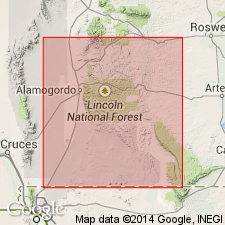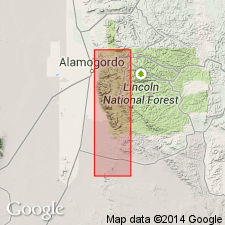
- Usage in publication:
-
- Beeman formation
- Modifications:
-
- Areal extent
- Dominant lithology:
-
- Shale
- Limestone
- Conglomerate
- AAPG geologic province:
-
- Orogrande basin
Summary:
Pg. 93. Beeman formation of Magdalena group. Appears only on columnar section. Consists of shale, argillaceous limestone, and conglomerate. Bioherms at base locally. Thickness as much as 500 feet. Underlies newly named Holder formation and overlies newly named Gobbler formation. Age is Late Pennsylvanian (Missourian).
[Notable exposures in Sacramento Mountains, Otero Co., southeastern NM.]
Source: US geologic names lexicon (USGS Bull. 1200, p. 278).

- Usage in publication:
-
- Beeman formation
- Modifications:
-
- First used
- Dominant lithology:
-
- Limestone
- Shale
- Sandstone
- AAPG geologic province:
-
- Orogrande basin
Summary:
First published description as one of four formations of the Magdalena group. Intent to name not stated. Type section is on Long Ridge, sec 15, T17S, R10E, Otero Co, NM in the Orogrande basin. Cross sections, columnar section. Overlies Gobbler formation (first used). Basal contact is a change from quartzose sandstone (below) into feldspathic sandstone (above). Underlies Holder formation (first used). Upper contact mapped at base of discontinuous algal bioherms. Consists of thin-bedded argillaceous limestone interbedded with calcareous shale, and locally green-gray feldspathic sandstone. Thin dolomite forms base along much of the western escarpment. Ranges from 350 to 500 ft thick. Middle and upper Missourian fusulinids in upper part. Generalized geologic map.
Source: GNU records (USGS DDS-6; Denver GNULEX).

- Usage in publication:
-
- Beeman formation
- Modifications:
-
- Overview
- AAPG geologic province:
-
- Orogrande basin
Summary:
Was named for Beeman Canyon, T16S, R10E. Type section 395 ft thick in Mule Canyon and Long Ridge area, NW1/4 NW1/4 sec 14, and NE1/4 NW1/4 and NW1/4 NE1/4 sec 15, T17S, R10E, Otero Co, NM, Orogrande basin, measured and described. Consists of gray, thin- to thick-bedded limestone (about 50 percent) interbedded with olive-gray shale, green-gray, fine-, medium- to coarse-grained, feldspathic sandstone, siltstone, and gray finely crystalline dolomite at type. Some of the limestone beds have limestone nodules 1-3 inches thick; some have fusulinids; some are dolomitic; some are argillaceous. Ranges from 350 to 500 ft thick. Facies changes occur abruptly. The type has basinal facies. In central part of escarpment, shoal-water marine facies present. Mapped the length of escarpment. Geologic map, cross sections, columnar section. Overlies Gobbler formation; contact usually placed at base of thin bed of brown-weathering dolomite or dolomitic limestone. Another recognizable feature is that Gobbler sandstones are quartz sandstones or subgraywackes whereas Beeman sandstones are feldspathic. Underlies Holder formation. Topmost limestone of Beeman is thin-bedded at type; lowermost limestone of Holder is massive. Has fusulinids of middle to late Missourian age.
Source: GNU records (USGS DDS-6; Denver GNULEX).
For more information, please contact Nancy Stamm, Geologic Names Committee Secretary.
Asterisk (*) indicates published by U.S. Geological Survey authors.
"No current usage" (†) implies that a name has been abandoned or has fallen into disuse. Former usage and, if known, replacement name given in parentheses ( ).
Slash (/) indicates name conflicts with nomenclatural guidelines (CSN, 1933; ACSN, 1961, 1970; NACSN, 1983, 2005, 2021). May be explained within brackets ([ ]).

